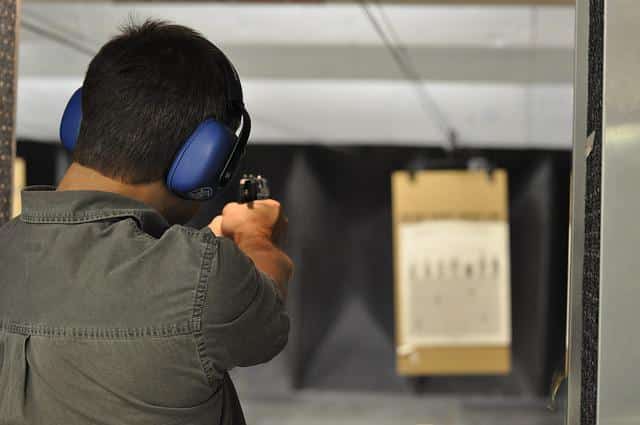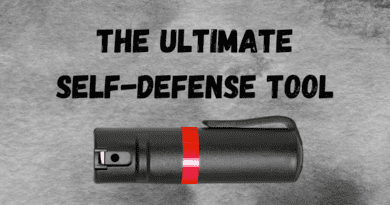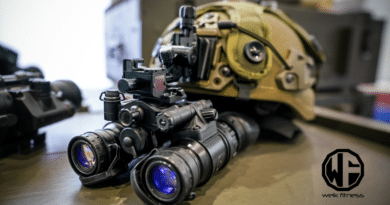Are Online Concealed Carry Courses Actually Worth Taking?
First and foremost, I think everyone should consider taking firearms courses. Everything from firearms safety to concealed carry courses. Everyone should understand how to properly and safely use a firearm to protect themselves.
That said, there is a difference between in-person concealed carry courses and online concealed carry courses. Both are beneficial, but in this article, I want to take a deep dive into how you can leverage online concealed carry courses to improve your skills and have a list of takeaways that you can work on while at the live-fire range as well as while dry-firing at home.

Table of contents
- In-Person Versus Online Concealed Carry Courses
- ConcealedCarry.com Complete Home Defense: Tactics for Defending Your Castle
- ConcealedCarry.com Vehicle Firearms Tactics
- ConcealedCarry.com Fighting from Cover with Unconventional Shooting Positions
- Mountain Man Medical Emergency Trauma Response
- The Bottom Line
In-Person Versus Online Concealed Carry Courses
Point blank, in-person concealed carry courses will be your best bet as you will get real-life, hands-on experience at them. It’s challenging to watch online concealed carry courses and learn the fundamentals and strategies they teach if you’re not doing them with the instructor.
Related Article: Jon Hauptman Talks PHLster and Improving Concealed Carry
However, that’s not to say you can’t learn life-saving skills while taking online concealed carry courses. In fact, I just took three of them to see how they compare to the other in-person as well as DVD instruction videos that I’ve taken over the years.
Let’s unpack my findings with the online concealed carry courses I recently took.
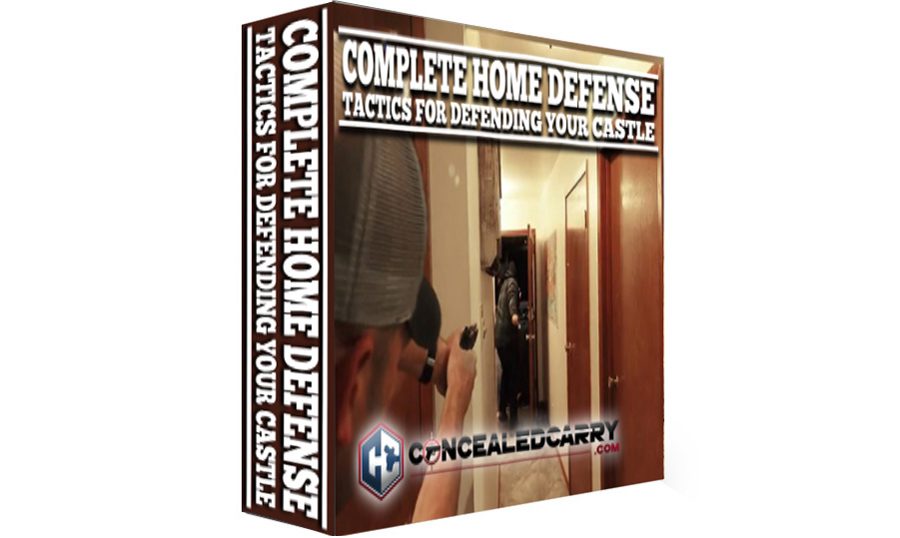
ConcealedCarry.com Complete Home Defense: Tactics for Defending Your Castle
When you think of online concealed carry courses, you probably think of the ones that are 60 minutes or less and skim over the main points. Honestly, I’ve taken those — and they’ve sucked. When I saw the ConcealedCarry.com Complete Home Defense: Tactics for Defending Your Castle course, I thought it was just like all the other online concealed carry courses I’ve taken. I couldn’t have been any more wrong!
The ConcealedCarry.com Complete Home Defense: Tactics for Defending Your Castle course is intense. This is one of the concealed carry courses that I would recommend everyone check out. It has over eight hours of instruction that allows you the ability to go lesson by lesson at your own pace. This is also important because, after a lesson, you can easily go practice what you were just shown.
Related Article: Is It Necessary for You to Carry a Firearm at Home?
If you want to be prepared in the event that someone attempts or succeeds at breaking into your home, this course is invaluable in your preparation, and I highly recommend taking the time to take this course.
This course is available online as well as by purchasing the DVD set.
Here is what’s covered in this course:
Disc 1: Preparing Your Fortress:
- How neighbor relationships can be helpful and important in your strategy
- The proper way to maintain landscaping to minimize risks
- Exterior lighting and surveillance video options and strategies
- Securing Entry Points
- Tools to prevent door ambushes and forcible entry
- Safe Rooms & Their Attributes
- Where and How to Hide and Stage Firearms for Quick Access
- How to Pick out and Where to Place Firearms Safes to Maximize Access and Minimize Risk
- How to choose between Carbines, Handguns, Shotguns, and PCCs
- The best tools, accessories, and methods for staging each of those firearms
- Analyzing different rifle, shotgun, and handgun ammunition for home use
- Lights and Lasers
- Improvised Weapons
Disc 2 – Securing the Advantage
- How to Use Fatal Funnels to Your Advantage and How to Not Get Stuck in Them
- Means of Egress and the Importance of Not Cornering the Animal
- Considerations for Wild Animals and Household Pets
- How to Find and Prepare Lanes of Fire
- Over Penetration – A Real-World Test of Different Firearms and Ammunition in Penetrating Through Drywall and Home Walls
- How to Tactically Prepare Exterior Structures Like Detached Garages, Tool-sheds, Barns, and Your Vehicles
- The 5 Fundamentals of Home Defense & Home to Apply These to Your Defense Plan
- How to Properly Answer the Door and Deal with Necessary Strangers Like Repair People
- Why and How to Carry a Gun in the Home, Including a Look at Off Body Carry
- What Tools to Stage in Each Safe Room
- How to Barricade Family in A Safe Room
- Means of Escaping and Leveraging the Safe Room Chokepoint
- How to Clear Rooms and Move Through the House to Get to Loved Ones
- One Easy to Remember Strategy to Dealing with Home Intruders That You Can Use to Build and Practice the Best Response Plan
- A Look at Common Objects and Furniture in The Home That Will and Won’t Stop Bullets
- A Clear Roadmap and Template for Building Your Own Response Plans
- How To Run Dry Fire Practice Sessions
- How to Apply Dry Fire Practice in The Home Environment
- How to Properly Prepare and Teach Teenagers Who Are Left Home Alone
- Best Practices for Babysitters and Other Responsible Adults in Your Home
- How To Approach an Empty Home You are Renting or Showing As a Realtor
Disc 3 – A Tactical Response
- How to Choose Between Handheld & Weapon-Mounted Lights
- The Different Techniques for Using a Handheld Light
- How To Use a Light Including Movement Through The Home In the Dark
- Retaining Your Firearm When Moving Through Transitional Spaces
- How to Win a Fight Over Your Gun
- Team Tactics and Working with Other Trained Respondents
- A Review of Law That is Universally Applicable in All 50 States About When You Can Use Deadly Force
- Medical Trauma Care of Loved Ones
- How to Place the 911 Call and What Information to Provide to Dispatch
BONUS: In this course, you will see seven unique re-enactments of different home attack situations based on real stories that will provide contextual lessons you can’t learn any other way. These include what happens when you get ambushed at the door, reacting to the bump in the night, moving through and using fatal funnels, using team tactics with a spouse or friend, properly identifying targets, and much more.
Related Article: Mantis BlackbeardX AR15 Dry Fire System — Better Than SIRT?
If you are interested in checking out this course, click here. I have no affiliation with ConcealedCarry.com and am not incentivized to promote this course. At the end of the course, you are presented with a certificate you can print out.
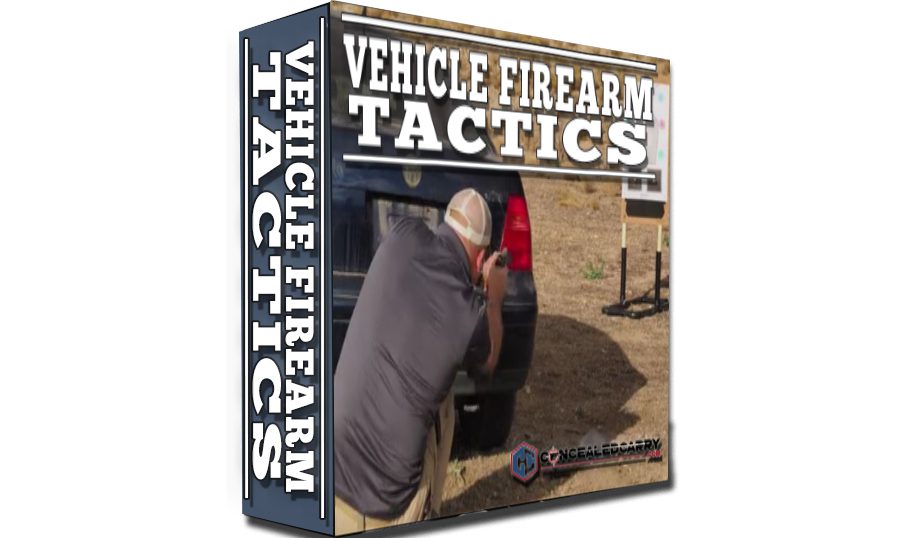
ConcealedCarry.com Vehicle Firearms Tactics
Driving in your car, you may feel safe due to the high safety standard of the car manufacturer. Unfortunately, your vehicle is a bullet magnet and ultimately a death trap if violence occurs.
In-person courses, in this instance, will be better than taking online concealed carry courses surrounding this topic, but that doesn’t mean you can’t take a bunch of knowledge and strategy away from an online course, such as this one.
Related Article: Mantis X10 Elite: The Most Comprehensive Shooting System Ever
After taking this vehicle firearms tactics course, there were a few things that I hadn’t considered until seeing it in their instruction.
Being able to understand what happens when a bullet hits the windshield, side windows, car door, or pillar is important. This course teaches you those things and more by providing you with a visual instruction course that covers everything you need to know and comprehend about fighting from a vehicle and how to fight your way out of one.
Here is what’s covered in this course:
- 3 primary counter-intuitive yet optimal positions to get the most cover in a vehicle fight
- Why the glass in the windows may be your most useful tool in fighting from inside the car
- How being too close to the vehicle when outside could cause you to expose yourself to your assailant
- A psychological weakness any human might have that you can exploit, understand this secret, and you can use non-bulletproof parts of the car as a weapon
- The proper technique for a “compressed ready position”
- How to aim naturally without hitting objects in the car
- What to change about your grip for greater accuracy within a vehicle
- The glass double-tap technique and when to use it
- How to handle an attacker if your window is down
- 7 common pieces of car gunfighting advice that are COMPLETELY false
- How to shoot behind you, especially if you’re driving (HINT: it’s not how it looks in the movies)
- 5 common “self-muzzling” mistakes and how to avoid them
- Seated draw: what’s different and what 1 thing MUST you do to avoid dangerous mistakes
- Stealth draw position – draw from this position, and you’ll always have the element of surprise on your side
- 1 handed shooting techniques and how to practice every scenario
- What to consider if you drive often with strangers, perhaps as a professional driver, whether you drive for Uber, Lyft, or UPS
- Proper Fighting Positions for passenger attacks from behind
- What to do with your gun if you feel you need to draw yet want your gun to remain hidden
- The secret safe ready position: How, why, and when to use it
- [IMPORTANT] The Vehicle attack decision matrix: when to evade, when to fight, and which weapon to use
- How Do Different Kinds of Glass Break & What About Tinting
- Deflection and How That Impacts Shooting Through Glass and Using the Car as Cover
- The difference between FMJs vs. Hollow Points when shooting through Glass and The Car
- The Proper Priorities When Considering Your Defensive Options
- Carry Position and Holster Considerations
- Draw Stroke and Presentation on Target
- How to Draw and Make Ready in The Vehicle
- Dealing With Threats from Multiple or Different Directions
- Dealing With Passengers in The Car
- Support Hand Shooting Considerations
- Bailout. How to Fight Your Way Out
- How to Bail Out and Shoot Through the V
- Car Cover, Concealment, and Angles
- Getting Shots on Target From any Position
- Tactical Considerations Shooting into the Vehicle
- Getting Out of the Way and Putting Shots on Target
- Penetrating Through the Door and Glass
Plus, Force on Force Demonstrations that will show you the reality of a gunfight and how to stack the odds in your favor.
If you are interested in checking out this course, click here. I have no affiliation with ConcealedCarry.com and am not incentivized to promote this course. At the end of the course, you are presented with a certificate you can print out.
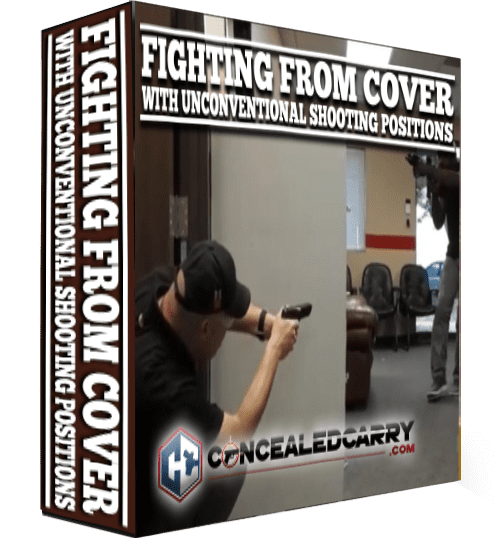
ConcealedCarry.com Fighting from Cover with Unconventional Shooting Positions
Another area that many people should focus on when it comes to concealed carry courses is how to fight from cover. The last thing you want to have happen is you and a shooter are standing out in the open and you’re taking fire without anything between you and the bad guy.
When rounds start popping off, identify the threat and take cover if possible while keeping your eyes down range on the target. Taking a shooting from cover class will help prepare you for such a situation by helping you understand and grasp the necessary skills and tactics to employ when using cover as well as the various shooting positions you may be put in when behind cover.
Related Article: Is the RangeTech Shot Timer Something You Should Invest In?
Additionally, concealed carry courses like this one will provide you with the tools needed to take the skills to the practice range and get confident in moving to cover, shooting from it, and becoming proficient.
Here is what’s covered in this course:
- How safety rules apply to compromised shooting positions
- A change in the paradigm of traditional cover vs concealment
- The proper method of slicing the pie when working with cover
- How to find the right balance of distance off cover given your current threat
- The dangers of being too close OR too far off your cover
- Dealing with and even taking advantage of physical limitations
- How to manage mechanical offset with handguns or rifles to get shots on your threat
- What everyday objects provide good cover in a home, in a workplace, and in public
- All the various shooting positions you can use to get shots on any target: Over a street curb, Under around or over a car, Around a pillar or wall, through a crack or hole in a surface, and much much more
- A review of important considerations that vary between a handgun and a rifle
- How to move to cover and WHEN and HOW to shoot when moving VS just moving quickly
- What it means to Pay for Space and Then Own it to increase odds of winning the fight
- The special Tony predictability drill
- Several proven way and tools to increase stress in training to simulate real world environments
- A review & analysis of 4 actual gunfights using surveillance video with John Correia
- Demonstration on how use of cover applied in those gunfights
- Review of drills to run on a live fire range to build skills related to those kinds of situations
- Four active shooter scenarios crafted and acted out for educational purposes
- Analysis of active shooter events and the proper application of cover
If you are interested in checking out this course, click here. I have no affiliation with ConcealedCarry.com and am not incentivized to promote this course. At the end of the course, you are presented with a certificate you can print out.
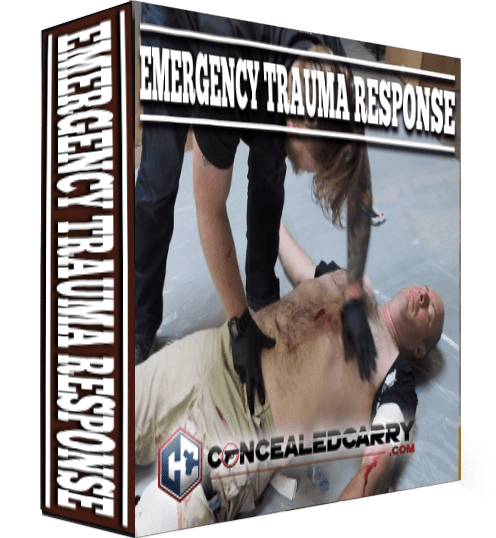
Mountain Man Medical Emergency Trauma Response
While medical training may not fall under the umbrella of concealed carry courses, this is another necessity that everyone should know and understand. You are far more likely to need to help someone medically than you ever will be to draw your firearm and engage a threat.
With medical training, you can help people in a car wreck, help people who suffered an injury while you’re away from home, and even help others and yourself in the case where violence breaks out and you need to help yourself, a family member, or those around you in an emergency.
A massive hemorrhage can be life-threatening, just as a gunshot wound can be. Understanding how to handle and manage these situations can mean the difference between life and death.
The Emergency Trauma Response course that I took covered:
- Trauma Medicine & Combat Mind Set
- The Gear of a Medic
- Vital Signs and Anatomy
- Intro to MARCH
- Massive Hemorrhage
- Airway
- Respirations
- Circulation
- Hypothermia & Head Trauma
- Reassessment
- Other Injury Types
- Practical Tourniquet Exercises & Improvised Solutions
- Your Role as a Medic
This information is so important that I have a link that you can use to take this course for FREE. I don’t have any affiliation with Mountain Man Medical and am not incentivized to provide you with this link. I merely believe this is something you should take and have the ability to share this offer with you without any cost. If you take concealed carry courses and carry a firearm daily, you should understand how to apply medical to stop massive bleeding. At the end of the training, you get a certificate of completion that you can print out.
To register for your free emergency trauma response course, please click here.
If you are in need of some medical equipment, here is what I would recommend you start with along with links:
The Bottom Line
The take-home message here that I want to put in your head is that regardless of what you choose, something is better than nothing. Online concealed carry courses can be incredibly useful, such as the courses I mentioned in this article. Likewise, in-person concealed carry courses are incredibly helpful as you get hands-on experience while taking the class. And ladies, don’t be afraid. There are even female-specific training classes for you!
Regardless of the way you lean with concealed carry courses… get training, practice what you learn, and become a harder target.
Related Article: Next Level Training SIRT Pistol — The Best Laser Dry Fire Tool?
If you want some in-person training, check out Bulletn — a website dedicated to showing you all the classes available in your area throughout the year.
And as always, go out and get the proper training needed to be proficient with your firearm(s) and EDC gear. I am not an instructor or tactical ninja, and I don’t pretend to be one on the weekends. I’m simply someone who seeks knowledge, improvement, and proficiency when it comes to self-defense and the ability to protect my family and those around me. You are your own first line of defense, seek the training of a certified and experienced instructor.


*Disclosure: This article may contain affiliate links or ads, which means we earn a small commission at no extra cost to you if you make a purchase through these links. These commissions help support the operation and maintenance of our website, allowing us to continue producing free valuable content. Your support is genuinely appreciated, whether you choose to use our links or not. Thank you for being a part of our community and enjoying our content.
PLEASE CONSIDER SHARING THIS ON YOUR SOCIAL MEDIA TO HELP OTHERS LEARN MORE ABOUT THIS TOPIC.


